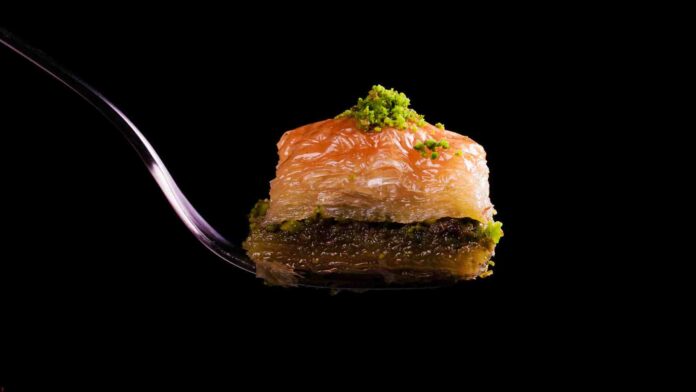Learn how to make the best homemade baklava with a honey-lemon syrup and layers of flaky, buttery phyllo dough. This easy baklava recipe will become a favorite for holidays and special occasions.
Baklava is a classic dessert loved for its crispy, buttery layers and sweet nut filling. This homemade baklava recipe outshines store-bought versions with its perfectly balanced honey-lemon syrup and a hint of cinnamon. Whether you’re preparing it for a holiday celebration or simply indulging in a special treat, this recipe guarantees delicious results every time.
Why You’ll Love This Baklava Recipe:
- Flaky and Crisp: Layers of phyllo dough brushed with butter create a crispy, flaky texture that holds together beautifully.
- Not Overly Sweet: The lemon juice in the syrup cuts the sweetness, leaving a perfectly balanced flavor.
- Family and Crowd Favorite: This baklava recipe is a hit at gatherings, and it’s easy to make ahead!
Key Ingredients for Baklava Recipe:
- Phyllo Dough: You’ll need a 16 oz package of phyllo dough (thin sheets) for this recipe. Avoid thicker phyllo as it won’t produce the same flaky texture.
- Walnuts: Ground walnuts create the traditional nutty filling. You can substitute with pistachios for a twist.
- Butter: Essential for brushing each layer of phyllo, giving it that signature crisp texture.
- Honey and Lemon Juice: The star of the syrup, providing sweetness with a tangy edge that prevents the baklava from being overly sweet.
How to Make Baklava Recipe (Step-by-Step):
1. Prepare the Syrup First
For best results, make the syrup before assembling the baklava, so it has time to cool.
- Combine 1 cup of sugar, ½ cup honey, 2 tbsp lemon juice, and ¾ cup water in a saucepan.
- Bring to a boil, then reduce heat and simmer for 4 minutes.
- Remove from heat and let the syrup cool completely.
2. Assemble the Baklava
Ingredients for Assembly:
- 16 oz phyllo dough
- 1 cup melted butter
- 4 cups ground walnuts
- 1 tsp cinnamon
- Prepare Phyllo Dough: Trim phyllo sheets to fit a 13×9-inch pan. Keep the dough covered with a damp towel to prevent drying.
- Layer Phyllo and Nuts: Butter the bottom and sides of the pan. Place 10 sheets of phyllo, buttering each layer. Spread ¾ cup of walnut mixture over the dough.
- Repeat Layers: Continue layering, alternating between 5 buttered sheets and walnut mixture until you’ve used up the nuts. Finish with 10 buttered sheets.
- Cut and Bake: Slice the pastry into 1½ inch-wide strips, then diagonally cut to form diamond shapes. Bake at 325°F for 1 hour and 15 minutes until golden brown.
3. Add the Syrup
Immediately after removing the baklava from the oven, pour the cooled syrup evenly over the hot baklava. This ensures that the layers absorb the syrup without becoming soggy.
Tips for the Best Baklava:
- Use Room Temperature Phyllo: Let the dough sit out for an hour before assembling.
- Don’t Skimp on Butter: This ensures every layer gets crispy and golden.
- Let Baklava Rest: For best flavor, let it sit uncovered for 4-6 hours or overnight. This helps the syrup fully absorb into the layers.
- Garnish for Extra Flair: For a touch of elegance, sprinkle finely chopped nuts or drizzle melted chocolate over the baklava before serving.
Storage and Serving:
- Storage: Baklava can be stored at room temperature, covered with a tea towel, for up to 2 weeks. It actually tastes better after sitting for a few days, as the syrup penetrates the layers further.
- Serving: Baklava is perfect for special occasions, holidays, or simply a sweet indulgence. Serve with a cup of tea or coffee for the ultimate experience.
Watch Our Baklava Video Tutorial:
For visual learners, check out our step-by-step video tutorial on how to make the perfect baklava, including tips on layering and cutting the dough for flawless results.
FAQs
1. What is traditional baklava made of?
Traditional baklava is made from layers of thin phyllo dough filled with a mixture of finely chopped nuts, such as walnuts, pistachios, or almonds. These layers are sweetened with a syrup or honey, often flavored with ingredients like lemon juice, cinnamon, and sometimes rosewater or orange blossom water. Butter or oil is used to brush each layer, creating a rich and flaky texture once baked.
2. What is the difference between Turkish and Greek baklava?
While both Turkish and Greek baklava share similar basic ingredients, there are subtle differences in preparation and flavor:
- Nuts: Turkish baklava often uses pistachios, especially in regions like Gaziantep, whereas Greek baklava commonly features walnuts or almonds.
- Syrup: Turkish baklava syrup may include ingredients like lemon juice and more pronounced spices, while Greek versions might incorporate honey and cinnamon more prominently.
- Phyllo Dough: The layering technique and thickness of phyllo can vary, with Turkish baklava typically having thinner, crispier layers.
- Shape and Presentation: Greek baklava is often cut into smaller diamond or square shapes, whereas Turkish baklava might be larger and cut into narrower pieces.
3. Why is baklava famous in Turkey?
Baklava is famous in Turkey due to its deep historical roots and cultural significance. It is a staple in Turkish cuisine and is often associated with celebrations, holidays, and special occasions. Regions like Gaziantep are renowned for their exceptional baklava, contributing to Turkey’s reputation for high-quality, delicious baklava. The meticulous preparation, use of premium ingredients like pistachios, and the perfected balance of sweetness and texture have all cemented baklava’s fame in Turkey.
4. What is the secret to crispy baklava?
The secret to crispy baklava lies in several key factors:
- Phyllo Dough: Using very thin, high-quality phyllo dough and ensuring each layer is brushed with melted butter or oil helps achieve crispiness.
- Layering Technique: Properly layering the phyllo sheets without overlapping too much allows for even baking and a flaky texture.
- Baking Temperature: Baking at a high enough temperature ensures that the phyllo becomes golden and crispy without becoming soggy.
- Syrup Application: Adding the syrup at the right time—after baking when the pastry is still hot—prevents the phyllo from absorbing too much moisture, maintaining its crispness.
5. Is baklava Arabic or Turkish?
Baklava has roots in the culinary traditions of the Ottoman Empire, which encompassed regions of both modern-day Turkey and the Middle East, including Arab countries. While it is a prominent dessert in Turkish cuisine, variations of baklava are also found across many Arabic-speaking countries. Therefore, baklava can be considered both Turkish and part of broader Middle Eastern (including Arabic) culinary traditions.
6. Is baklava a dish of Turkey or Israel?
Baklava is a traditional dessert found in both Turkish and Middle Eastern cuisines, including Israel. It is enjoyed in various forms across many countries in the region, each with their own unique twists and ingredients. While Turkey is particularly renowned for its baklava, especially in cities like Gaziantep, Israel also has its own beloved versions of the dessert. Thus, baklava is a shared culinary heritage rather than belonging exclusively to one country.
7. Which country makes the best baklava?
Determining which country makes the best baklava is subjective and often depends on personal taste preferences. Some of the top contenders include:
- Turkey: Particularly the city of Gaziantep is famous for its pistachio baklava, known for its rich flavor and high-quality ingredients.
- Greece: Known for its use of walnuts and honey, Greek baklava is celebrated for its sweet and aromatic profile.
- Lebanon: Lebanese baklava often includes a variety of nuts and unique flavorings like orange blossom water.
- Balkan Countries: Countries like Albania and Bosnia also have their own cherished versions of baklava.
Ultimately, the “best” baklava is a matter of personal preference, with each region offering its own delicious take on this classic dessert.
8. Is baklava healthy?
Baklava is a rich and indulgent dessert, typically high in calories, sugar, and fat due to its ingredients like phyllo dough, butter, nuts, and sweet syrup or honey. While it does contain healthy fats and proteins from nuts, the high sugar and fat content mean it should be enjoyed in moderation as part of a balanced diet. Consuming baklava occasionally can be part of a healthy lifestyle, but regular or excessive intake may contribute to health issues related to high sugar and fat consumption.
9. How long does Turkish baklava last?
Turkish baklava can last for about 1 to 2 weeks when stored properly. To maximize its freshness:
- Room Temperature: Store in an airtight container at room temperature, where it will stay fresh for up to a week.
- Refrigeration: For longer storage, keep it in the refrigerator, which can extend its shelf life to about two weeks.
- Freezing: Baklava can also be frozen for up to three months. Ensure it is well-wrapped to prevent freezer burn. Thaw at room temperature before serving to restore its texture.
Proper storage helps maintain the crispness of the phyllo layers and the integrity of the syrup, ensuring the baklava remains delicious.
This baklava recipe is not only delicious but also easy to make at home. By following these step-by-step instructions and our best tips, you’ll achieve a dessert that’s flaky, crisp, and perfectly balanced. Whether you’re making it for a special occasion or just to treat yourself, this baklava is sure to impress.
Source : natashas kitchen
Visit our Turk Blogs homepage for more articles.





